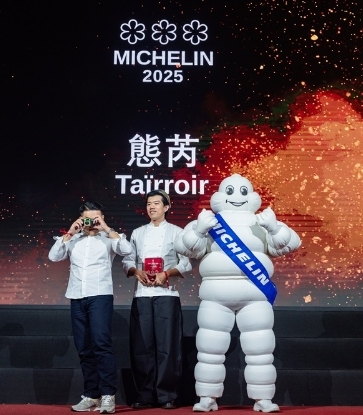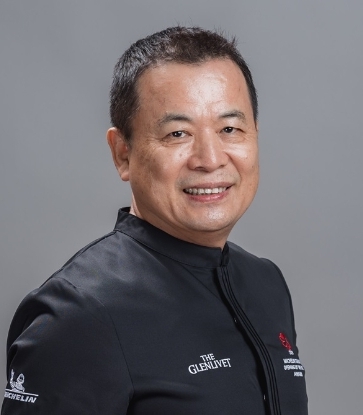Chef Zaiyu Hasegawa of Den, a Tokyo establishment with two MICHELIN stars and a green star, had his first encounter with aiyu jelly during his first visit to Taiwan. He was delighted with his discovery and even brought some back to Japan. “This is something that Japanese people don’t know about. They think it’s kanten jelly, but the texture is different,” he says. “Everyone finds it incredible.”

It was then that he fell in love with the ingredient. Hasegawa recently came to Taiwan as a guest chef to celebrate the 10th anniversary of his friend Richie Lin’s Taipei MICHELIN-selected restaurant MUME. One of the highlights of this one-day-only dining event was a dessert bowl featuring hand-kneaded aiyu jelly with black sugar syrup, two types of cantaloupes from Japan and Taiwan, as well as fruits like mango, wax apple and grapes. Eight years ago at MUME, he had also created a fruit punch using Taiwanese fruits, but the aiyu was soaked in watermelon juice instead; chia seeds and tapioca pearls are then added, together with a bonito broth, to create a rich and novel flavour profile.
RELATED: Two Nourishing Cantonese Soups by Chefs of Taipei’s MICHELIN Restaurants

Over at Sho, a one-MICHELIN-starred restaurant and Den’s outpost in Kaohsiung helmed by Den’s former sous chef Shoichi Fujimoto, a palate cleanser of handmade aiyu jelly, mango granita, candied lemon and grapes are served after its signature kamameshi (iron pot rice). This cold, sweet pre-dessert refreshes the guests’ palates in preparation of the upcoming dessert.
RELATED: What MICHELIN Inspectors Said about Sho

A One-of-a-kind Ingredient
Aiyu jelly is an ingredient unique to Taiwan, and Taiwan is the only place in the world that can produce this plump and chewy delicacy.This is because the fig wasp that pollinates the jelly fig can only survive and reproduce in Taiwan. Aiyu seeds come from fig plants, where flowers are hidden inside the fruit. This small wasp would burrow into the male fruit through the opening at the top to lay eggs. After the male and female wasps hatch and mate inside the fruit, the female wasp then carries the pollen and flies to another jelly fig. Even if it enters a female fruit, which is not suitable for laying eggs, the wasp will still pollinate it, allowing the female fruit to continue maturing. Once the female fruit is ripe, the achene can be harvested. By scraping the jelly-fig seeds from inside the fruit, placing them in a cotton cloth and kneading them in water, the refreshing and smooth aiyu jelly is formed.
The jelly fig plant and fig wasp have a symbiotic relationship. The jelly fig provides a safe and fertile environment for the fig wasps to thrive; in turn, the fig wasp pollinates the jelly fig, ensuring that the plant will continue to survive and grow.
This type of wasp is highly sensitive to its environment and has limited flight abilities so it’s not able to fly to other locations. This renders fig wasps a species unique only to Taiwan, meaning that aiyu jelly is a one-of-a-kind ingredient that can only be produced in Taiwan.

Aiyu jelly that has been hand-kneaded in water has a mild and smooth texture. While it doesn’t have a strong flavour of its own, aiyu jelly is an ingredient of great versatility. Kneading aiyu jelly in fruit juices or teas, for example, allows the jelly to acquire these distinct flavours. Beyond the traditional preparations of lemon or syrup to make icy desserts, some add coke, beer, broth or even make aiyu jelly into a warm sweet soup.
Aiyu Jelly at MICHELIN-starred Restaurants
Found at night markets, at corner stores and small alleyway shops, and enjoyed as an after-school dessert, aiyu jelly is a culinary collective memory for Taiwanese people. It has also made appearances in creations by chefs of MICHELIN-recommended restaurants, who showcase their creative interpretations in honour of this world-class local ingredient.
At Taipei’s two-MICHELIN-starred establishment logy, aiyu jelly has been a signature dessert since the restaurant’s opening. Hand-washed wild aiyu is paired with carbonated young coconut flesh with a fizzy texture, or pineapple juice infused with basil. The aiyu coconut jelly beloved by Taiwanese people has been elevated with a flavour complexity through these creative renditions.
Over at JL Studio, a three-MICHELIN-starred restaurant in Taichung, chef Jimmy Lim leverages the texture of aiyu jelly to reinvent the class Singaporean dish of bak kut teh: Xinshe shiitake mushrooms, porcini and other mushrooms, along with garlic and black pepper, are cooked into a broth; alongside sautéed Guguan abalone and morsels of Xinshe king oyster mushroom, aiyu jelly is used to mimic the mouthfeel of lard. The dish is topped with a piece of fried shiitake mushroom and shredded burdock to create a wholly vegetarian version of bak kut teh.
RELATED: Inspired By Singapore: Jimmy Lim’s Signature Dishes At Three-Starred JL Studio In Taiwan

Richie Lin of MUME is another chef who has incorporated aiyu jelly in savoury dishes. An Indonesian-Chinese who grew up in Hong Kong and Canada, Lin has long been fascinated by Taiwan’s abundant ingredients. He has spent many hours learning about aiyu jelly through academic papers and experimenting with kneading it in various liquids and slow-blending it in a food processor. He discovered that as long as aiyu jelly is not overly broken apart, it can achieve the same gelatinous effect as hand-kneading.
After 11 years in Taiwan, chef Lin has created all kinds of aiyu dishes. One notable creation was crafted by presenting aiyu jelly in a warm, savoury preparation: he kneaded aiyu jelly in a bonito broth, imparting the aiyu with the fragrance and umami of the broth. The jelly was then served in a hot fish soup. “The properties of aiyu jelly are different from those of gelatin. Its gelling point is not dependent on temperature,” he shares.
Endlessly transformable and truly one-of-a-kind, aiyu jelly has opened up boundless possibilities for the world of gastronomy.
This article was written by the MICHELIN Guide and translated by Iris Wong. Read the original article here.
Hero image: ©Shutterstock























